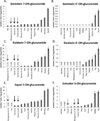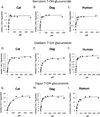Soy isoflavone metabolism in cats compared with other species: urinary metabolite concentrations and glucuronidation by liver microsomes
- PMID: 26366946
- PMCID: PMC4967369
- DOI: 10.3109/00498254.2015.1086038
Soy isoflavone metabolism in cats compared with other species: urinary metabolite concentrations and glucuronidation by liver microsomes
Abstract
1. Soybean is a common source of protein in many pet foods. Slow glucuronidation of soy-derived isoflavones in cats has been hypothesized to result in accumulation with adverse health consequences. Here, we evaluated species' differences in soy isoflavone glucuronidation using urine samples from cats and dogs fed a soy-based diet and liver microsomes from cats compared with microsomes from 12 other species. 2. Significant concentrations of conjugated (but not unconjugated) genistein, daidzein and glycitein, and the gut microbiome metabolites, dihydrogenistein and dihydrodaidzein, were found in cat and dog urine samples. Substantial amounts of conjugated equol were also found in cat urine but not in dog urine. 3. β-Glucuronidase treatment showed that all these compounds were significantly glucuronidated in dog urine while only daidzein (11%) and glycitein (37%) showed any glucuronidation in cat urine suggesting that alternate metabolic pathways including sulfation predominate in cats. 4. Glucuronidation rates of genistein, daidzein and equol by cat livers were consistently ranked within the lowest 3 out of 13 species' livers evaluated. Ferret and mongoose livers were also ranked in the lowest four species. 5. Our results demonstrate that glucuronidation is a minor pathway for soy isoflavone metabolism in cats compared with most other species.
Keywords: Cat; daidzein; dog; equol; genistein; glucuronidation; isoflavone; soy.
Conflict of interest statement
Figures




Similar articles
-
Distribution of isoflavones in samples of serum, liver and mammary glands of rats or pigs fed dietary isoflavones.Ann Nutr Metab. 2011;58(3):171-80. doi: 10.1159/000328771. Epub 2011 Jun 8. Ann Nutr Metab. 2011. PMID: 21654164
-
Isoflavones modulate the glucuronidation of estradiol in human liver microsomes.Carcinogenesis. 2005 Dec;26(12):2172-8. doi: 10.1093/carcin/bgi197. Epub 2005 Jul 28. Carcinogenesis. 2005. PMID: 16051636
-
Isoflavone metabolism in domestic cats (Felis catus): comparison of plasma metabolites detected after ingestion of two different dietary forms of genistein and daidzein.J Anim Sci. 2013 Mar;91(3):1295-306. doi: 10.2527/jas.2011-4812. Epub 2013 Jan 10. J Anim Sci. 2013. PMID: 23307849
-
Sex and long-term soy diets affect the metabolism and excretion of soy isoflavones in humans.Am J Clin Nutr. 1998 Dec;68(6 Suppl):1500S-1504S. doi: 10.1093/ajcn/68.6.1500S. Am J Clin Nutr. 1998. PMID: 9848524 Review.
-
Effect of S-equol and Soy Isoflavones on Heart and Brain.Curr Cardiol Rev. 2019;15(2):114-135. doi: 10.2174/1573403X15666181205104717. Curr Cardiol Rev. 2019. PMID: 30516108 Free PMC article. Review.
Cited by
-
Identification of equol-7-glucuronide-4'-sulfate, monoglucuronides and monosulfates in human plasma of 2 equol producers after administration of kinako by LC-ESI-MS.Pharmacol Res Perspect. 2019 May 9;7(3):e00478. doi: 10.1002/prp2.478. eCollection 2019 Jun. Pharmacol Res Perspect. 2019. PMID: 31086672 Free PMC article.
-
Effects of Isoflavone Intake on Energy Requirement, Satiety, and Body Composition of Neutered Adult Cats.Animals (Basel). 2024 Dec 11;14(24):3574. doi: 10.3390/ani14243574. Animals (Basel). 2024. PMID: 39765478 Free PMC article.
-
Glucuronidation: driving factors and their impact on glucuronide disposition.Drug Metab Rev. 2017 May;49(2):105-138. doi: 10.1080/03602532.2017.1293682. Epub 2017 May 22. Drug Metab Rev. 2017. PMID: 28266877 Free PMC article. Review.
-
Distribution and metabolism of daidzein and its benzene sulfonates in vivo (in mice) based on MALDI-TOF MSI.Front Pharmacol. 2022 Aug 10;13:918087. doi: 10.3389/fphar.2022.918087. eCollection 2022. Front Pharmacol. 2022. PMID: 36034806 Free PMC article.
-
Soy and Health Update: Evaluation of the Clinical and Epidemiologic Literature.Nutrients. 2016 Nov 24;8(12):754. doi: 10.3390/nu8120754. Nutrients. 2016. PMID: 27886135 Free PMC article. Review.
References
-
- Atkinson C, Frankenfeld CL, Lampe JW. Gut bacterial metabolism of the soy isoflavone daidzein: exploring the relevance to human health. Exp Biol Med (Maywood) 2005;230:155–170. - PubMed
-
- Broussard JD, Peterson ME, Fox PR. Changes in clinical and laboratory findings in cats with hyperthyroidism from 1983 to 1993. J Am Vet Med Assoc. 1995;206:302–305. - PubMed
-
- Cerundolo R, Court MH, Hao Q, Michel KE. Identification and concentration of soy phytoestrogens in commercial dog foods. Am J Vet Res. 2004;65:592–596. - PubMed
-
- Cimino CO, Shelnutt SR, Ronis MJ, Badger TM. An LC-MS method to determine concentrations of isoflavones and their sulfate and glucuronide conjugates in urine. Clin Chim Acta. 1999;287:69–82. - PubMed
Publication types
MeSH terms
Substances
Grants and funding
LinkOut - more resources
Full Text Sources
Other Literature Sources
Miscellaneous
